![]() Heaven signifies night
and day, cold and heat, times and seasons.
Heaven signifies night
and day, cold and heat, times and seasons.
Earth comprises distances, great and small; danger and security;
open ground and narrow passes; the chances of life and death.
[Sun Tzu, The Art of War - I .7,8]
In traditional GO, the number of connections of a usual cell (i.e., not in the edge of the board) is 4. If it is changed the number of connections, we get different flavors of the original game.
To play in a board with 6 connections, we get an hexagonal board and play inside the cells. I.e.,
This game tends to be more strategic and less tactical, since a direct attack to one isolated piece is much less efficient than in typical Go. An adversary needs 6 pieces to capture an isolated piece. To play this game on the intersections (and more related stuff) check xah lee's site.
All numbers, besides the typical 3,4 and 6 connections, need strange looking boards, since the only regular patterns that can tile a plane are the triangle, the square and the hexagon. In fact, there are just three ways to tile a plane with two different shapes keeping the 5 connections. Here is one way to make a board where a non edge cell has 5 connections (called 33344 which denotes the order of the polygons around each vertex; in this case, three triangles followed by two squares).
This board gives an intermediate point between the typical Go and the hexagonal Go. I think that, despite the odd shape, this can be the best variant based on connection numbers. Other ways are the 33336 and 33434:
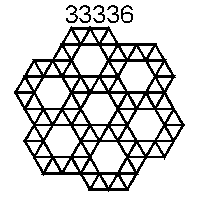 |
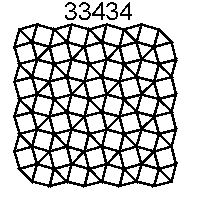 |
It is also possible to make an arbitrarily large extended smooth patch (ESP) around any smooth patch of squares and equilateral triangles that will tile the plane. This yields a nice round board with 5 connections per vertex, but the board is not homogeneous so tactics vary on different parts of it (I wish to thank Edward Jackman for these diagrams).
|
|
This is the most typical sort of connection, used in all square boards that are used to play Go, Checkers, Chess... Other possible tilings are the 3636 and the 3464:
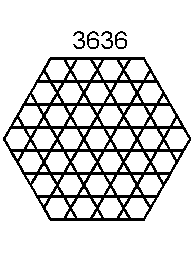 |
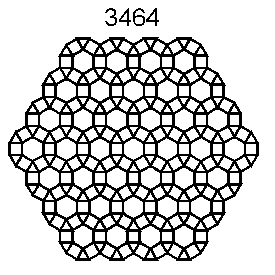 |
To play in a board with just 3 connections, we get an hexagonal board and play in the intersections. I.e.,
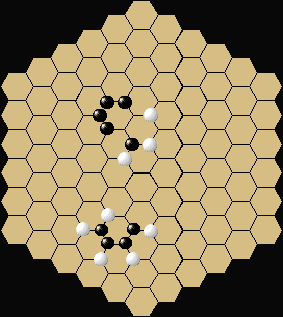
This game tends to be less strategic and more tactical. The average liberty of each piece is lower, so an attack to any individual piece or small group is more effective. Three moves are enough to capture one isolated piece. An stone in Atari cannot escape that easily, extending that piece only provides one extra liberty (not two in Go), so the opponent can maintain the threat (check the Atari race above).
A game called Rosette, invented by Mark Berger at 1975, is based on this concept. He created a special pattern, called rosette (a ring of stones covering a small hexagon) that has implicitly 2 eyes. Two games by Freeling are based in this idea: Medusa and Lotus.
Other type of games can be played on this board. David Smith's Spangles use this triangular connections in the following rules: (a) On each turn, each player must drop a friendly stone adjacent to one or two stones (of either color) - there is an initial stone at the board center, (b) Wins the player that surrounds exactly one stone (of either color) with three friendly stones.
Given the other natural numbers, the game does not make sense for 1 connection (each piece is isolated and uncapturable) or 2 connections (each group of stones that makes contact with an opponent stone can be captured on the next move).
Boards with more than 6 connections tend to not have any tactical interest, since it is very difficult to capture any group of stones, except perhaps at the end of game. Even so, it is much more easy to connect a line of stones into two living eyes created on the edges, than to encircle and capture them.
So, in my opinion, the only variations that make some sense are the 3, 4, 5 and 6 connections. From them, perhaps the most interesting is the 5 variant
Other type of connections are possible. Instead of presenting it in the shape of the board, we can also define that the connections between pieces are different. In topological terms it is the same thing.
Knight Connections Each piece is connected with others at a chess knight jump. This variant means that each piece has a liberty of eight, too much, as seen before, to make an interesting tactical game.
Fairy Connections There are many ways to redefine the piece's connection properties. In the left image there are some 3 and 4 connection patterns. For e.g., in the top left, there is a non symmetric way to connect pieces, so the piece protects another one placed in one of the green dots, but it is not protected by it.
Toroidal Connections The top line is connected at the bottom line and the right connected to the left. So, there is no edges and thus, no limits. It is much harder to make territories.
In this variation type, the board gains one or more holes, i.e., there are a number of cells that cannot be played. I present here two possible boards:
Well, I did play a few games with a modified board. We arbitrarily "cut out" the central 5X5 points, leaving a symmetric toroid. The most interesting difference was the new kind of "exterior" corners produced by the hole. Of course, the hole also isolated Joseki that involved ladders from the diagonally opposite corner. The variant also has an advantage in that the board is easy to make - just cover the center with a piece of paper. All in all though, the variant seemed too simple. The center obviously was less important, and the games "just" involved a series of unrelated tactical fights.
Jim Bonomo
I've done similar things, but removing a lot more of the center leaving a 4 wide "ring" (i.e., the handicap points are these concave points) then the 3-3 points (1-1 from the concave corners) are VERY powerful.
Steve Bailey
Gregory K. Van Patten has a webpage with some other ideas on this subject. Two of them follows:
45 flip degrees Flip your GO board 45 degrees, and still use the horizontal/vertical connections. You get a new battle field!
Hexagonal Cuts To create a new hexagonal board, carefully cut the boundaries of a regular hexagonal board, in a way to make all six bounding edges look like the same.
Round Go by Harald Schwarz Standard Go rules apply, and each point still has four liberties (even on the outside edges). There is some information about this board in here.
Cairo Tiling by Mark Thomson. You can find about the Cairo tiling at Mark's website. Other pentagonal tilings can be found at http://www.mathpuzzle.com/tilepent.html. Check also the Geometry Junkyard.
Open GO, by Gregory K. Van PattenThis idea (a Go board with no discrete cells) already appeared on many different places and times. The main problems are to define capture (since liberty is not well defined, if there is no finite set of adjacent cells) and territory (remember, no more discrete board).
Open Go needs a circular board and stones aprox. 1/20th of the board diameter. A stone may be placed if (a) does not overlap any other stone, and (b) there is space to eventually drop another stone touching the previous one. In the figure, both players may drop a stone at cell [1] since it satisfies both conditions.
If Black drops at [2], it will capture the White chain - they have no more liberty, i.e., there is no space left t
o drop a friendly stone near the White chain.
Ko fights as in [3] are not well defined on continuous Go (because the position may never repeat itself, if we consider that we are dealing with real coordinates). This means that both players should be reasonable and accept the evidence of a Ko situation (this may be difficult in certain positions, if both captured stones may progressively shift into a non Ko situation - but I'm not sure if this can happen...)
A stone structure like in [4] is alive, since no Black stones can enter in any of those two 'holes' without gaining any freedom!
Wins the player that has the greater sum of placed stones (Chinese rules) plus the number of stones that can be placed on his territory!
Greg proposes some mental challenges: Consider that Black stones are larger than White stones, who gets the advantage? Given a certain constant stone area, what should be the best shape for a stone? And what about using non-symmetric board shapes to prevent mirror tactics?
Free Placement Go, by Pekka Karjalainen
This variant is similar to Open Go, but is played on a square board.
The notion of connectivity is different (at least on the surface) and goes like this (Pekka's words): Any two circles are defined to be connected if a line can be drawn between their center points that does not intersect any other circle. Also, it must not be intersected by a line drawn between two circles of opponent's color that is shorter or of equal length to this first line.
Wins the player that has the greater area of territory. This is harder to compute (strange polygon areas) and may cause problems if the players does not count any placed stones or captured enemies!
Henry Segerman has another variant called Continuous Go, where two stones are connected if and only if they touch each other. He generalized the idea into Topological Go [but beware, that website is not for the weak of heart].
John Rickard proposes the same capturing rule as Open Go, but the counting method is different: wins the player with more stones in the board. That means the endgame will be longer. He also proposes that if there is no rule to pass, the first player that cannot place a stone, looses!
I believe that all these ideas are very similar and they reflect basically the same game. Even the different winning conditions would give the same result on any typical endgames. I found, however, a big problem with these continuous variants, how to play them? If we use a computer, we must restrict ourselves to limited rationales, and that means that the board is not continuous and approaches discrete Go on an hexagonal board. If played face to face, it will be very hard to place the stones without moving the ones already placed. The exact position of a stone can be decisive!
The idea is to first define a set of cells in arbitrary coordinates and then adapt the board to this configuration. The best way to perform this is by using the Voronoi algorithm to create 'areas of influence' for each defined cell. More information about Voronoi algorithm and implementations can be found here. Here is an applet made by Zhiyuan Zhao (left click to insert a point, right click to delete the nearest point).
If two players want to play Go on a random board, they just need to randomly insert N points into the board, compute the Voronoi cells and play (the first two steps can be automated by a program like this one, of course). Each area too small to include a stone can be (a) an hole (like in the edge) or (b) a free liberty that cannot be occupied. These two options give rise to two very different Go games.
One possible extension of Go to 3 dimensions is to allow extra liberties to be created for each cell. This approaches 3D Go variants to the hexagonal board variants. A variant from L. Lynn Smith:
Go3D is a two-player game played upon a 5x5x5 field and follows the rules of 2D Go.
Black begins the game with 63 Stones, White with 62.
Like in 2D Go, you must deny your opponent's Stones their 'liberties' in order to capture them. In Go3D, there are potentially two extra 'liberties', one above and one below.
The ending of the game after one player passes two consecutive turns is enforced by the players.
When the last stone is played, or there are no legal moves, or both players pass together, the game is over.
This game has a Zillions file.
Another Go variant with more than one board (but not quite 3D) is Galice.
For the men of Wu and the men of Yueh are enemies; yet if they are crossing a river in the same boat and are caught by a storm, they will come to each other's assistance just as the left hand helps the right. XI, 30